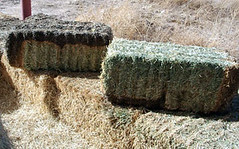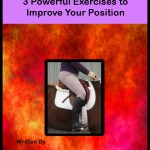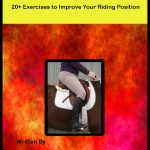The Horse Hay Test – Should I Test My Hay
Whether you have 1 horse of many doing the horse hay test is important. This past summer has had its share of challenges, with the rain, and no rain, and did I mention the lack of rain. It has been great for hay making and storage.
Does Horse Hay Really Need To Be Tested?
Every so often my nutritionist (read sales rep for Brooks’s grain, Tania) comes by to update and check on my feeding schedule. More often than not she asks, “Have you tested your hay?” I always respond with a resounding, “No”. It costs money and I often wonder if I test throughout the mow, it really doesn’t represent what I’m feeding. One bale may be from field ‘a’ in the back 40 and the next could be beside the highway and who knows from where in between.
I think I will start saying yes to Tania, my feed nutritionist to the hay test question next time because every hay bale I open up I give it the Laura-May test.
The Laura May Horse Hay Test

1. Lift bale – if it is heavy it probably means it has gotten wet and/or mouldy so it should be put aside to return to the supplier. My supplier is wonderful about this. If the hay is not good he will let me return it and will give me other bales in exchange.
2. Look at the contents of the bale – If it is alfalfa or majority alfalfa then again I set it aside to feet sparingly to babies, or horses in work.
3. Open Bale – if there is dust, mould or other then toss it.
This is just a basic test and all kidding aside I do study the hay before feeding. I know my fescue from my vetch, and trefoil from my alfalfa.
As the old saying goes you only have one chance to make a first impression and after opening a bale the contents are fully scrutinized.
Things I check for: Continuation of the Laura May HOrse Hay Test:
4. Visual – the bale must be visually appealing. And I mean really, were not talking Mr. Universe here. It has to be green(ish) and free of mould (see 2. above) and be loose stems. Packed stems breeds mould and keeps dust. If the bale does not come apart when you open it then it probably means it got wet or not dried properly prior to baling so beware.
5. Aroma – If must smell fresh and ‘clean’. If you start to sneeze or are coughing up phlegm (I just wanted to type phlegm) beware. If there are mouldy, mildewy smells then don’t feed it. Use it for mulch on your neighbour’s garden, as the weeds will grow so don’t use it on your own.
6. Quality – This determines the nutritional value of the hay. The value is in the flower and leaf. Less value is in the stem. There should be a higher proportion of leaves then stem.
7. Types of Plants – Take note of the types of grasses and legumes present. Also there should be no weeds, thistles, burdocks etc which reduces the forage quality and prevents proper drying of the hay when it is harvested. Take the time to learn the types of grasses and legumes so you know what you are getting.
I’ve been known to fluff, soak and steam a few bales to get by with some dubious bales just to be on the safe side. Dusty hay can lead to a host of horse related ailments that are not worth having. Keep diligent and you can perform the Laura May Test before feeding your horse its hay.


 Try these three powerful exercises to get strengthen your position.
Try these three powerful exercises to get strengthen your position.

Funny – I have some heavy bales that I open up and find a rock inside. Can’t be too good on the equipment. The other thing to consider on hay is the cutting. Usually earlier cuttings (first) are more nutrient rich than later ones (2nd or 3rd).
These are all very good suggestions. My dad was always very careful about the hay we bought when we had our farm, Sweetbrier and our horses were happy.
Thank you for your comments. Getting good hay is important to the happiness and well being of your horse. If your horse has good quality hay then it should be fit and healthy.
~Laura
Oh my I hope you haven’t had to buy hay by the pound!! 🙂
yes I didn’t get into the first/second cut of hay. I think with hay if it is fresh and no dust/mold then we can supplement with grain if necessary.
I also think the quality of the nutrient is dependant on the types of grasses/legumes in the field to be cut. around here 2nd and 3rd cut have more nutrients in them as we have timothy/alfalfa mix and the first cut is 70%timothy/30% alfalfa the second cut is 70% ALFALFA 30% TIM/grasses and the 3rd cut is almost 100% ALFALFA
I would never think of giving my horse a 3rd cut hay. WAY to rich and 2nd cut is too rich for my horses. If Ihad a mare in foal I would possibly feed it to them.
take a look at this where it outlines 2nd and 3rd cut hay are more nutrient rich.
http://www.omafra.gov.on.ca/english/livestock/horses/facts/info_hay.htm
I don’t know if it would over lap but I use this list for my piggies timothy hay check (https://smallpetselect.com/timothy-hay-updates/6-surefire-ways-spot-top-quality-timothy-hay). Might help with horse hay?
Thank you so much for this. Great photo of your rabbits. Do you ever get your hay tested?